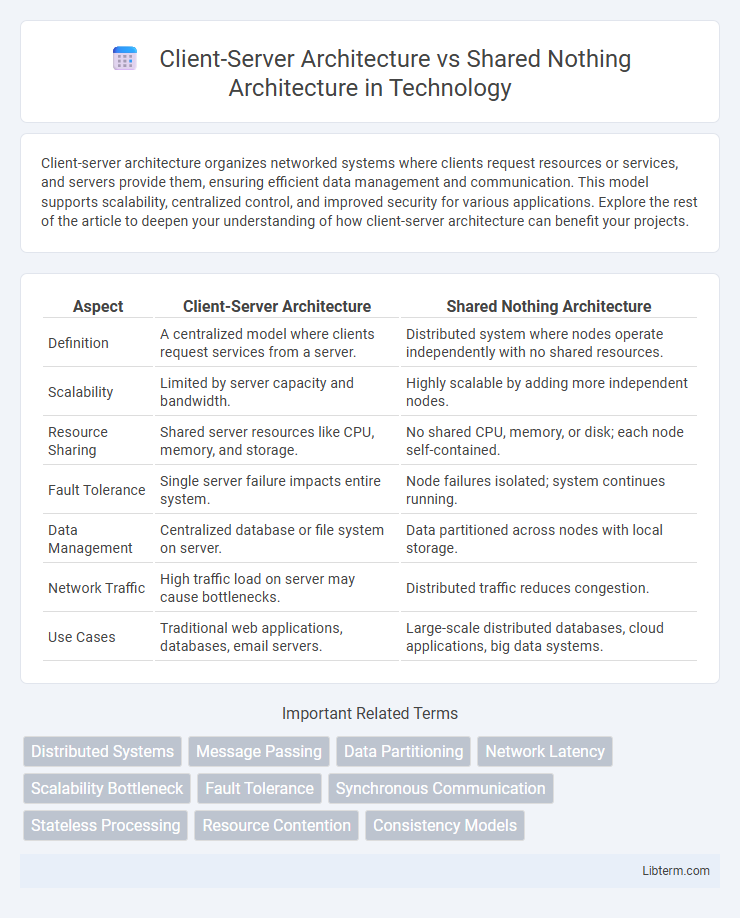Client-server architecture organizes networked systems where clients request resources or services, and servers provide them, ensuring efficient data management and communication. This model supports scalability, centralized control, and improved security for various applications. Explore the rest of the article to deepen your understanding of how client-server architecture can benefit your projects.
Table of Comparison
| Aspect | Client-Server Architecture | Shared Nothing Architecture |
|---|---|---|
| Definition | A centralized model where clients request services from a server. | Distributed system where nodes operate independently with no shared resources. |
| Scalability | Limited by server capacity and bandwidth. | Highly scalable by adding more independent nodes. |
| Resource Sharing | Shared server resources like CPU, memory, and storage. | No shared CPU, memory, or disk; each node self-contained. |
| Fault Tolerance | Single server failure impacts entire system. | Node failures isolated; system continues running. |
| Data Management | Centralized database or file system on server. | Data partitioned across nodes with local storage. |
| Network Traffic | High traffic load on server may cause bottlenecks. | Distributed traffic reduces congestion. |
| Use Cases | Traditional web applications, databases, email servers. | Large-scale distributed databases, cloud applications, big data systems. |
Introduction to Client-Server and Shared Nothing Architectures
Client-server architecture organizes computing tasks between servers that provide resources or services and clients that request them, optimizing centralized control and resource management. Shared nothing architecture distributes data and workloads across independent nodes with no shared memory or disk, enhancing scalability and fault tolerance. This design reduces contention and allows parallel processing, making it suitable for large-scale distributed systems.
Core Concepts of Client-Server Architecture
Client-Server Architecture is a network model where client devices request services and resources from centralized servers that manage data, processing, and security. Core concepts include the division of roles between clients, which handle user interface and input, and servers, responsible for data storage, business logic, and resource management. This architecture supports scalability, centralized control, and efficient resource allocation by separating client and server responsibilities.
Principles of Shared Nothing Architecture
Shared Nothing Architecture is designed around the principle that each node operates independently with its own memory, disk, and processing power, eliminating resource contention and single points of failure. This decentralization improves scalability and fault tolerance by distributing data and workload across multiple nodes that do not share hardware components. Unlike Client-Server Architecture, which relies on centralized servers to manage resources and requests, Shared Nothing Architecture enhances performance through parallel processing and autonomous operation of nodes.
Key Differences Between Client-Server and Shared Nothing Architectures
Client-server architecture centralizes processing tasks on a server that manages client requests, whereas shared nothing architecture distributes processing and storage across independent nodes with no shared resources. Scalability in shared nothing architecture is enhanced due to the elimination of resource contention, allowing seamless horizontal scaling, unlike client-server setups where server bottlenecks may occur. Fault tolerance is inherently higher in shared nothing systems because node failures do not affect others, contrasting with client-server models where server failure can disrupt overall service availability.
Scalability and Performance Comparison
Client-Server Architecture often faces scalability limits due to centralized resource management, which can create bottlenecks and reduce performance under heavy loads. Shared Nothing Architecture enhances scalability by distributing data and processing across independent nodes, eliminating contention and enabling linear performance growth as nodes increase. This distributed approach leads to improved fault tolerance and load balancing, resulting in superior performance for large-scale, high-concurrency applications.
Fault Tolerance and Reliability Aspects
Client-Server Architecture relies on central servers, making it susceptible to single points of failure that can degrade fault tolerance and reliability. Shared Nothing Architecture distributes data and processing across independent nodes, enhancing fault tolerance by isolating failures and maintaining system availability. This decentralization improves overall reliability, as node failures do not compromise the entire system.
Data Consistency and Management Approaches
Client-Server Architecture centralizes data management on a central server, simplifying data consistency through controlled access, but can create bottlenecks and single points of failure. Shared Nothing Architecture distributes data across independent nodes, enhancing scalability and fault tolerance while requiring complex coordination protocols like distributed transactions or eventual consistency to maintain data integrity. Data consistency in client-server models relies on strict locking mechanisms, whereas shared nothing systems often employ replication and consensus algorithms to manage concurrent updates and ensure synchronization across dispersed data stores.
Use Cases and Suitability
Client-Server Architecture suits applications requiring centralized control, such as web services and enterprise resource planning (ERP) systems, offering easier management and security. Shared Nothing Architecture excels in distributed systems like large-scale web applications and data warehousing, providing high scalability and fault tolerance by isolating failures across nodes. For workloads demanding horizontal scaling and minimal contention, Shared Nothing Architecture is ideal, while Client-Server fits scenarios needing centralized data consistency and control.
Real-World Examples and Case Studies
Client-server architecture powers applications like email systems and banking platforms, where centralized servers handle requests from multiple clients, ensuring controlled access and data consistency. Shared nothing architecture is exemplified by distributed databases like Google Spanner and Apache Cassandra, enabling horizontal scalability and fault tolerance by isolating data storage and processing across independent nodes. Case studies of Netflix highlight the shift from client-server models to shared nothing architectures to support massive user loads with minimal downtime through microservices and distributed caching.
Choosing the Right Architecture for Your Application
Choosing the right architecture depends on your application's scalability and data consistency requirements; Client-Server Architecture centralizes control, simplifying management and security for smaller scale systems, while Shared Nothing Architecture excels in horizontal scalability and fault tolerance by distributing data and processing across independent nodes. Applications needing high availability and massive scalability benefit from Shared Nothing due to its ability to minimize contention and single points of failure. Evaluate workload patterns, consistency models, and infrastructure costs to determine the optimal architecture that balances performance, reliability, and resource efficiency.
Client-Server Architecture Infographic

 libterm.com
libterm.com